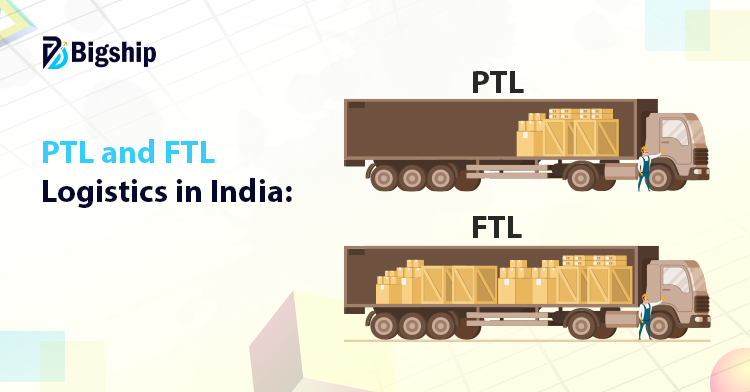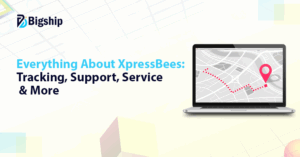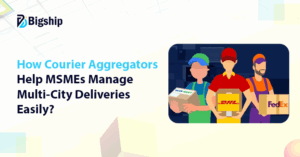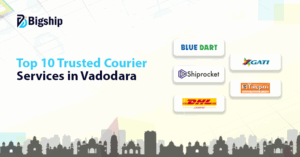The shipping industry is growing rapidly, fast delivery is becoming a crucial factor to meet customer needs in today’s business world. E-commerce logistics plays an important role in helping businesses to stay competitive and also to meet their demands. The two most important logistics options are Partial Truckload (PTL) and Full Truckload (FTL), which offer various advantages depending on the type of shipment.

Let’s explore what PTL and FTL shipping are all about — their benefits, drawbacks, and which option works best for different business needs.
What is PTL logistics?
Partial Truckload or PTL is the perfect choice if your shipment or parcel does not cover the entire truck. It’s suitable for those businesses that ship parcels regularly, typically between 6-18 feet of trailer space. PTL helps to reduce the costs as you have to pay only for the space you use. PTL offers a smart, efficient, smooth, and budget-friendly solution for flexible delivery concerns of manufacturers or retailers.
Benefits of PTL
PTL has several advantages, and the main ones are mentioned below.
Cost Saving– In PTL, you have to pay only for the space you used. It’s a cost-effective solution for businesses that are shipping smaller loads, helping to reduce the expenses of logistics.
Reduce Inventory- PTL enables more frequent shipments and helps to lower the storage costs, and keeps inventories easy and manageable.
Environmental Impact-
As PTL combines multiple shipments in one truck, it reduces the number of vehicles on the road, which helps to cut down the fuel usage and lower the carbon footprint.
PTL is Ideal For
- Small or medium-sized shipments that do not require a full truckload.
- Businesses that don’t need urgent or same-day delivery.
- Manufacturers, retailers, and distributors who ship regularly across various regions.
- Those businesses that are looking for affordable transport without compromising speed and safety.
Drawbacks of PTL
Despite having advantages, PTL has a few disadvantages as well. Some them are given below.
- No control over delivery time, it might take more time as it makes multiple stops to drop off and pick up goods, which can cause delays in shipments.
- As PTL involves combining multiple shipments that cause delays in shipment due to coordination challenges or limited truck space during peak time.
How does PTL in logistics work?
PTL (Partial Truckload) logistics is like sharing a ride to deliver the parcel to save costs. Here’s how it works:
- A business contacts a logistics provider to ship goods based on your parcel size and requirements.
- Then the parcel is sent with the other parcels heading in the same direction by optimizing truck space, which helps to reduce the cost.
- The truck picks up the parcel with other partial loads, which can be from different suppliers and locations.
- Then the shipping partner starts dispatching the parcel to the delivery destination.
- Once the parcel reaches the delivery location, they are unloaded from the truck and delivered to the recipients.
What is FTL Shipping?
FTL (Full Truckload) shipping dedicates an entire truck for a single shipment. In this, the entire truck is occupied because of the size, weight, or because you’ve booked the entire truck for safe delivery. This ensures faster delivery, control over goods, minimizes the risk, and often affordable transportation, especially for heavy and bulky parcels.
Since the truck doesn’t share space with other shipments, it follows a direct route from pickup to the destination, avoiding unnecessary stops.
Benefits of FTL
FTL has several advantages, and these are mentioned below.
1. Faster Transit Time- As the truck goes directly from pickup to delivery location without stopping unnecessarily, that makes it a faster option.
2. Lower Risk Damage – As your parcels are not shared with other shipments, it’s easy to handle and also minimize the risk of damage, mixing or loss.
3. Cost-Effective for Large Shipments– If your parcel is large, FTL is more cost-effective and gives you control over how your parcel is loaded and transported.
4. Control & Tracking– Shipments can be controlled or scheduled according to the needs once they’re onboard.
FTL is Ideal For
- Large shipments that can be loaded on an entire truck.
- Deliveries that require direct transport from the origin to the shipment destination.
- Heavy or bulky orders that can fill the space and weight of the truck trailer.
Drawbacks of FTL
Some of the disadvantages of FTL are given below:
- Higher costs are paid for small shipments, making them inefficient and costly for small and normal-sized shipments.
- Sometimes trucks return empty after the delivery, which increases the transport cost.
PTL vs FTL logistics in India
FTL means your large or small shipments are loaded into the entire truck. Since the truck carries only your parcels, the delivery is faster with no stops in between. This means fewer chances of damage because less loading and unloading are involved. FTL is best for businesses that deliver in bulk and need quick and safe delivery.
PTL is when you have to send a small or partial load that doesn’t fill the full space of a truck trailer. The other space is filled with other PTL parcels. It’s a more affordable, time taking and also higher chances of damage as it is shared with other companies with whom the truck is shared.
Choosing the right fit: PTL vs FTL
PTL and FTL may be similar, but they both involve sharing the space with other shipments. But in reality, they both are just different kinds of logistic methods.
- Shipment Size- FTL is used to ship bulky and large parcels, whereas PTL ships small or normal parcels.
- Cost-effective- FTL is more expensive than PTL, as you have to pay for the entire truck trailer whether you use it completely or not. PTL is affordable, and you have to pay only for the parcel space used.
- Transit time- FTL takes less time as it is filled from one place and fewer stops, whereas PTL takes more time as it carries multiple parcels from different stops.
- Risk of Damage- FTL is less risky compared to PTL, as it moves less and isn’t repacked often, whereas PTL has a higher risk due to frequent loading and unloading.
Conclusion
The best logistics option isn’t about what is faster or what is cheaper, it’s all about what fits your shipment, timeline, and budget. If your business regularly ships large or time-sensitive parcels, FTL offers speed, safety, and control. But if your shipments are small in size and you’re looking to save money while staying efficient, PTL is a smart and flexible option.
At the end, choose what fits according to your customer’s expectations and align your logistics to help run the business smoothly.
If you need FTL or PTL services, sign up with Bigship!





